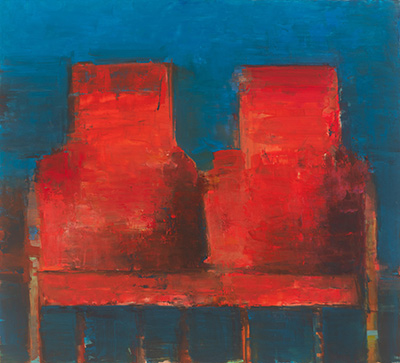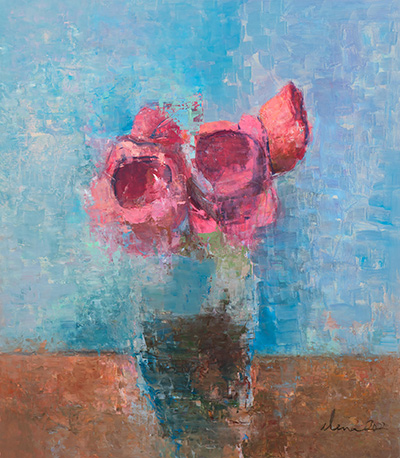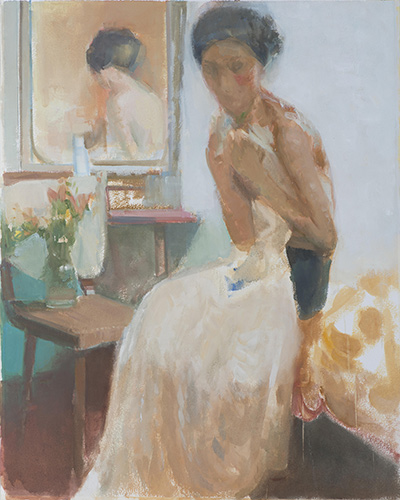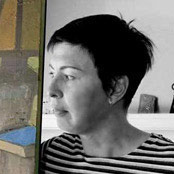ART '#eatpraylovepaint' at Bryant Street Gallery
shows off painter's broad range
by Sheryl Nonnenberg / Contributor
Palo Alto Online

"Red & Redder" oil on mylar on paper is part of Elena Zolotnitsky's Extinct Series, paintings of empty chairs that evoke a haunting sense of nostalgia. Courtesy Elena Zolotnitsky.
The title of Elena Zolotnitsky's solo exhibition at Bryant Street Gallery, on view until Dec. 23, is "#eatpraylovepaint," and it is a fitting hashtag for an artist who is passionate about the medium of painting.
Zolotnitsky, a native of Moscow who now lives in Oakland, has been painting for almost 40 years. In an email interview, she said that she grew up admiring the work of Flemish artists Johannes Vermeer and Pieter Breugel. More contemporary influences include Richard Diebenkorn, Luc Tuymans and Paul Cezanne. "These are at my core so to speak. Everybody else comes and goes," she noted, adding "Have you noticed how your likes change depending on where you are in life, or what you are becoming?"
Gallery owner Karen Imperial was drawn immediately to Zolotnitsky's paintings. "She's a very good painter and I wanted to give her a show because I thought it would be well-received," Imperial said. "It's representational and in the past I have focused more on abstraction."
Not only are the paintings representational but they also span three distinct categories: still-life, portrait and landscape. Quite often artists find that they excel in one area and focus on it for an entire career. Zolotnitsky said that "painting itself is the main subject" and that "I like to think of my artworks as 'sonnets' conveying my admiration for life, art, beauty and enchantment in a format of painting."

With pieces such as "Beyond Blue," painter Elena Zolotnitsky draws out a translucent quality from the saturated colors, giving the oil paint an effect similar to pastels. Courtesy Elena Zolotnitsky.
She is clearly enchanted with the temporal beauty of flowers, as can be seen in the simple elegance of "Yellow Rose" and "Beyond Blue." In these canvases, mature roses in shades of orange and red and contained in plain vases take center stage. Rendered in loose, brushy strokes, the flowers are given enough form to be recognizable without unnecessary detail. These are quiet nature studies in which the saturated colors take on a translucent quality that can usually be found in works made with pastels.
The artist has a special technique for achieving "softness and calm," which involves the use of oil paint on mylar. Zolotnitsky said that she was first exposed to the use of mylar through the work of another artist. She decided to try it and loved how the end product had a "sleeky sheen." She said that she felt it produced a "modern look" but not without lots of challenges. "Because of how sleek it is, you have to find your way in every one of your paintings. I find the media to be vibrant and lively."
Nine of the paintings in the show are part of the Extinct Series and feature empty chairs as subjects. When I shared with the artist that I found these paintings to be enigmatic, ghostly and full of memory, she was pleased. "Those are the exact emotions I strive to evoke," she said, adding, "By definition 'extinct' to me means nostalgia. And since the chairs mainly represent the characters who were at some point sitting in them and now no more — it was a good start."

For pieces like "Landscape: High Noon," Elena Zolotnitsky uses oil paints on a mylar surface, a technique that she says helps achieve an effect of "softness and calm." Courtesy Elena Zolotnitsky.
The empty chair is an oft-used trope for loss and emptiness. In some of the paintings, this singularly symbolic object is painted in a realistic manner. We can imagine the feel of the material in "Red & Redder" and "Turquoise Perfect." These are comfy pieces of furniture where a grandparent might sit and read. "Feeling of Being," on the other hand, appears to be constructed of wood and is very stiff and upright. Other works like "Disappearing Act" and "Safe Haven" seem to be in the process of fading before our eyes, perhaps as a distinct memory of a loved one will eventually recede from our minds. In "Majestic" and "Made to Order," the form of the chairs disintegrates almost completely, leaving just a whisper of a memory.
"I have been told that my paintings of chairs were presenting 'vacancies' as if the person had just left or was about to return," said Zolonitsky. How the viewer perceives them will probably be guided by where you are in your life. In any case, they are beautifully executed, evocative and thought-provoking.
There are three full-face portraits of women with long faces and symmetrical features. Painted in a generalized way, the viewer might wonder if they are all the same woman. But Zolotnitsky explains that the portraits, like her other work, are "archetypes — when the chair isn't really a chair, a flower isn't really a rose and a face isn't really a portrait." She went on to say that the face is really just a starting point — "a structure, a form is the space in time."
One portrait does seem to have more of a specific narrative. "Against the Light (Satin Wedding)" depicts a woman holding what appears to be a dress to her naked chest as she turns to look out at the viewer. She sits on the edge of a bed and the reflection of her back can be seen in a mirror in the background. The colors are soft and the whole look of the scene is reminiscent of many Impressionist paintings with similar subject matter. The indistinct rendering of the face, the tension in the torque of the body engenders a disquiet that is palpable. Zolotnitsky agreed, "The whole scene of serenity is, I thought, in contrast to the girl's doubt and anxiety."
Two landscapes, "High Noon" and "Blueberry Hill," probably come closest to the description of being abstract. In "High Noon," soft hues of orange and gold are used to depict a hill with hiking trails leading to a sun-filled horizon. The artist has allowed some of the mylar to peek out from the sky, adding a blue note. Here we can see how carefully the artist must work, applying oil paint to such a slick surface. When asked if her short, direct strokes are purposeful, Zolotnitsky replied, "Absolutely! Everything is purposeful, even if it is intuitive. You are just so lost in the moment that the tools are the only way to the light."

"Against the Light (Satin Wedding)," oil on paper by Elena Zolotnitsky, seems to have more of a specific narrative than some of the painter's other portraits, with a serene setting contrasting with the tension of how the subject is portrayed. Courtesy Elena Zolotnitsky.
After viewing the show it is easy to see why Zolotnitsky selected the hashtag, which she has been using for years. "It emphasizes the contrast between the world's social media madness and individuality. In order to not lose oneself in the modern time of technology, Instagram and (hashtags) — not to forget about the most important things in one's life. One of those for me is painting."
"#eatpraylovepaint" is on view through Dec. 23 at Bryant Street Gallery,
532 Bryant St., Palo Alto.
www.bryantstreet.com.
www.paloaltoonline.com/news/2022/11/10/eatpraylovepaint-at-bryant-street-gallery-shows-off-painters-broad-range

